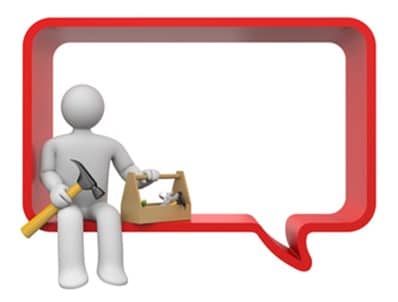Originally posted on November 30, 2014 @ 5:36 PM
Just Toolbox it!
 ‘Just Toolbox it!’ How often have you heard this term in risk and safety? It seems to be the key way we address safety concerns including incidents, hazards, a ‘safety alert’ or a ‘safety share’
‘Just Toolbox it!’ How often have you heard this term in risk and safety? It seems to be the key way we address safety concerns including incidents, hazards, a ‘safety alert’ or a ‘safety share’
As the name suggests, the ‘Toolbox Talk’ (also known as the ‘pre-start chat’, the ‘huddle’, the ‘first five minutes’, ‘Team Talk’, etc…..) first started with people chatting while sitting around their toolboxes. Like a lot of things in risk and safety, I’m sure it started as a good idea, a way of sharing key information, ideas and planning for the day ahead. However since ‘safety’ took it over, there is less focus on conversation, and more on ‘telling’.
When we only communicate in a one dimensional way, through ‘telling’ rather than engaging, we limit the opportunity to understand the views of others and whether people discern risks themselves.
So why has the ‘Toolbox Talk’ turned into the ‘Telling Talk’?
Perhaps one of the reasons is that the ‘Toolbox Talk’ has become one of the only ways that ‘safety’ is communicated. It’s often the place for rolling out the new procedure, warning about the dangers of a particular hazard or laying down the law on new safety ‘standards’. Rarely are ‘Toolbox Talks’ genuinely interactive. While there may be superficial questions such as “does anyone have any questions?” (where the hope is that people don’t!), or “does anyone have anything to add?” (I’ve lost count of the times I’ve heard people say yes, only for the manager to say ‘lets take that offline’), the reality is that Toolbox Talks are controlled by managers, and the agenda is regularly that of the manager.
Toolbox Talks are also often limited in time, and conducted at the start of the day/shift when work has to begin. There is rarely time to engage with people, so ‘telling’ becomes the order of the day.
So what can be done if your organisation has fallen into the trap of the ‘Toolbox Talk’ being one of the only ways you communicate with your team? Here are a few tips and ideas to think through which may make your safety communication program more effective:
1. Allow, organise and prioritise specific time for training where it is needed. Don’t try to cram important training into a time limited meeting like a Toolbox Talk.
2. Share information at a time that is appropriate. If the news is important enough to share, why wait until the next ‘Toolbox Talk’? Sharing information at a time that will help people make sense of it, will make it more effective.
3. Become better at conversations. Instead of the superficial “does that make sense to everyone?” at the end of a Toolbox Talk when people are keen to start work, allow time to have better conversations with people while they are working. This is the best way to understand whether they understand, and are able to deal with risk.
4. When having these conversations, think about the questions you ask. While talking with a safety team last week, we spoke about ‘asking’ rather than ‘telling’ (see – Gab Carlton on Humble Enquiry). We talked about open questions, i.e., those that aim to understand the views of others. They told me that they asked these type of questions all the time, sighting examples such as “why are you doing things that way?” or “have you been trained to do that job?”. These are not examples of open questions, and the people asking these questions have a clear agenda, it’s often about control. Instead, the key is to engage in conversation (see – Gab Carlton on Critical Listening) focusing on listening for cues to help you understand whether the person recognizes the hazards. If you’d like to understand more about effective conversations, you can attend one of Dolphyn’s Risk Training Programs.
Does your organisation rely on Toolbox Talks as the key way to communicate about safety? I’d love to hear about other people’s experiences on Toolbox Talks and effective communication about risk.



Do you have any thoughts? Please share them below